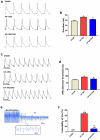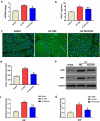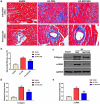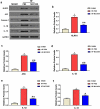MCC950 ameliorates ventricular arrhythmia vulnerability induced by heart failure
- PMID: 35287557
- PMCID: PMC9162026
- DOI: 10.1080/21655979.2022.2053813
MCC950 ameliorates ventricular arrhythmia vulnerability induced by heart failure
Abstract
MCC950, a specific NACHT, LRR, and PYD domains-containing protein 3 (NLRP3) inhibitor, has been reported to play a role in various cardiovascular diseases. However, its role in heart failure (HF)-induced ventricular arrhythmias (VAs) remains unclear. Hence, the present study aimed to clarify the role and underlying mechanisms of MCC950 in HF-induced VAs. Male C57BL/6 mice were induced with HF via transverse aortic constriction (TAC). Histological analysis, echocardiography, electrophysiological investigation, and western blot analysis were conducted to evaluate VA vulnerability induced by TAC and the potential mechanisms underlying the effects. MCC950 markedly improved cardiac function and decreased pulmonary edema induced by HF. Moreover, MCC950 also decreased VA vulnerability, as shown by the shortened QTc duration and action potential duration 90 (APD90), reduced APD alternans threshold, and decreased VA induction rate. Furthermore, MCC950 treatment significantly reversed TAC-induced cardiac hypertrophy and fibrosis. In addition, MCC950 administration increased the protein levels of ion channels (Kv4.2, KChIP2, and Cav1.2). Mechanistically, the above changes induced by MCC950 were due to the inhibition of the NLRP3 inflammasome. As a specific NLRP3 inhibitor, MCC950 significantly decreased HF-induced VA vulnerability by reversing cardiac structural remodeling and electrical remodeling, and the mechanism through which MCC950 exhibited this effect was inhibition of NLRP3 inflammasome activation.
Keywords: MCC950; NLRP3 inflammasome; heart failure; ventricular arrhythmias.
Conflict of interest statement
No potential conflict of interest was reported by the author(s).
Figures








Similar articles
-
Selective Inhibition of NLRP3 Inflammasome Reverses Pressure Overload-Induced Pathological Cardiac Remodeling by Attenuating Hypertrophy, Fibrosis, and Inflammation.Int Immunopharmacol. 2021 Oct;99:108046. doi: 10.1016/j.intimp.2021.108046. Epub 2021 Aug 10. Int Immunopharmacol. 2021. PMID: 34435581
-
The selective NLRP3-inflammasome inhibitor MCC950 reduces myocardial fibrosis and improves cardiac remodeling in a mouse model of myocardial infarction.Int Immunopharmacol. 2019 Sep;74:105575. doi: 10.1016/j.intimp.2019.04.022. Epub 2019 Jul 9. Int Immunopharmacol. 2019. PMID: 31299609
-
The selective NLRP3 inflammasome inhibitor MCC950 improves isoproterenol-induced cardiac dysfunction by inhibiting cardiomyocyte senescence.Eur J Pharmacol. 2022 Dec 15;937:175364. doi: 10.1016/j.ejphar.2022.175364. Epub 2022 Nov 3. Eur J Pharmacol. 2022. PMID: 36336012
-
Therapeutic potential of MCC950, a specific inhibitor of NLRP3 inflammasome.Eur J Pharmacol. 2022 Aug 5;928:175091. doi: 10.1016/j.ejphar.2022.175091. Epub 2022 Jun 14. Eur J Pharmacol. 2022. PMID: 35714692 Review.
-
Target of MCC950 in Inhibition of NLRP3 Inflammasome Activation: a Literature Review.Inflammation. 2020 Feb;43(1):17-23. doi: 10.1007/s10753-019-01098-8. Inflammation. 2020. PMID: 31646445 Review.
Cited by
-
Searching for Effective Treatments in HFpEF: Implications for Modeling the Disease in Rodents.Pharmaceuticals (Basel). 2023 Oct 12;16(10):1449. doi: 10.3390/ph16101449. Pharmaceuticals (Basel). 2023. PMID: 37895920 Free PMC article. Review.
-
The Role of Inflammasomes in Heart Failure.Int J Mol Sci. 2024 May 14;25(10):5372. doi: 10.3390/ijms25105372. Int J Mol Sci. 2024. PMID: 38791409 Free PMC article. Review.
-
Pyroptosis in cardiovascular diseases: roles, mechanisms, and clinical implications.Front Cardiovasc Med. 2025 Aug 4;12:1629016. doi: 10.3389/fcvm.2025.1629016. eCollection 2025. Front Cardiovasc Med. 2025. PMID: 40832143 Free PMC article. Review.
-
The role of Nod-like receptor protein 3 inflammasome activated by ion channels in multiple diseases.Mol Cell Biochem. 2023 Jun;478(6):1397-1410. doi: 10.1007/s11010-022-04602-1. Epub 2022 Nov 15. Mol Cell Biochem. 2023. PMID: 36378463 Free PMC article. Review.
-
Active ingredients of traditional Chinese medicine inhibit NOD-like receptor protein 3 inflammasome: a novel strategy for preventing and treating heart failure.Front Immunol. 2025 Jan 24;16:1520482. doi: 10.3389/fimmu.2025.1520482. eCollection 2025. Front Immunol. 2025. PMID: 39925805 Free PMC article. Review.
References
-
- Cygankiewicz I, Zareba W, Vazquez R, et al.; Muerte Subita en Insuficiencia Cardiaca Investigators . Heart rate turbulence predicts all-cause mortality and sudden death in congestive heart failure patients. Heart Rhythm. 2008;5(8):1095–1102. - PubMed
-
- Klein L, Hsia H.. Sudden cardiac death in heart failure. Cardiol Clin. 2014;32(1):135–144. - PubMed
-
- Baksi AJ, Kanaganayagam GS, Prasad SK. Arrhythmias in viral myocarditis and pericarditis. Card Electrophysiol Clin. 2015;7(2):269–281. - PubMed
-
- Pavlicek V, Kindermann I, Wintrich J, et al. Ventricular arrhythmias and myocardial inflammation: long-term follow-up of patients with suspected myocarditis. Int J Cardiol. 2019;274:132–137. - PubMed
-
- Haneklaus M, O’Neill LA, Coll RC. Modulatory mechanisms controlling the NLRP3 inflammasome in inflammation: recent developments. Curr Opin Immunol. 2013;25(1):40–45. - PubMed
MeSH terms
Substances
LinkOut - more resources
Full Text Sources
Medical
Research Materials
Miscellaneous
